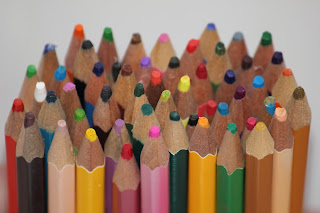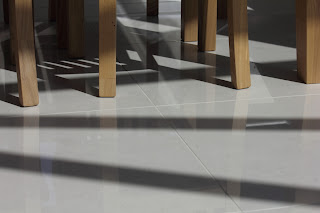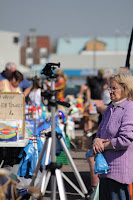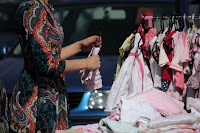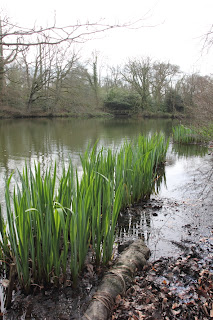From a list provided I have decided to demonstrate the following contrasts;
Large/Small
Many/Few
Diagonal/Rounded
Pointed/Blunt
Hard/Soft
Thick/Thin
Smooth/Rough
Straight/Curved
For the final photograph I have to display the contrast in one image.
Black/White
Below are samples of the final Photographs I have submitted for my Assignment.
LARGE
Contrast - Large
Being a member of the National Trust gives me great opportunity to visit some of England’s stunning stately homes and gardens. On this particular occasion I was taking a walk around Nymans in West Sussex where numerous people walk their dogs in the woods. This particular shot was taken as I stood chatting to the owners.
While processing the photographs from this day, I noticed how big the dog’s eyes were, and it immediately took me back to my childhood and old saying “Big Puppy Dog Eyes”
The photograph was taken at f4.5-1/250-200-17mm
I had to crop the photograph from the original, so that the finished image was more focused on the dogs face and eyes by using the rule of thirds. No other image correction techniques were used. Out of all of the photos taken I thought this portrayed the dogs innocence and beauty.
On reflection I would have liked to have gotten closure to the dog so I didn’t have to crop so much, which in turn would have made the photograph sharper. I didn’t sharpen the image, as a byproduct of this made the photo look to grainy.
SMALL
Contrast - Small
In contrast to my something ‘Large’ I wanted to keep the subject matter to something that wasn’t an imamate object. During a visit to Uppark in Hampshire, while sitting having lunch I noticed that the surrounding flowers were attracting the a few bees. Using my 55-250mm lens I followed the bees and took photographs of them whilst they were pollinating.
The photograph was taken at f16.0-1/320-3200-250mm
I decided not to edit this photograph, as I am quite happy with the contrast of colours and composition of the photo. While shooting I made every effort to compose the shot and think about the frame saving me time after processing the RAW images. The photo of the bee was taken as one of the bees was resting on a nearby leaf. With the insect still enough I was able to get as close as my lens would allow, which enabled me to focus in on the bee.
If I could have shown this better, then I would have chosen one of my other photos with the bee in flight, however on this occasion, it proved difficult to get a sharp enough photo that I was happy with.
MANY
Contrast - Many
Several months ago during my journey home I had noticed this field was being prepared for tree planting and every time I drove past the numbers would appear to increase. As I started this assignment this immediately came to mind to express the word ‘Many’.
The photograph was taken at f4.0-1/800-100-40mm
Several photos were taken from high level to low, with the view off centre to the final photo that I decided on. I liked the tunneling effect which enhances the view and makes you realise how vast and how many new trees have been planted.
Although I like the photo and feel it Illustrates the meaning well, perhaps a way to improve this would be to go back later in the year, so the trees are more developed and green, bringing more substance to the image.
FEW
Contrast - Few
This was slightly more challenging as finding something suitable was proving to be difficult. However one morning on the way to work, I drove past a field where I know several horses graze. The light was bright and low and set back in the distance just rising above the field, a few horses were present in the field at the time, and this seemed like the perfect opportunity I was waiting for.
The photograph was taken at f5.6-1/1250-100-250mm
With the sun low in the sky and the air quite hazy, getting the shot I wanted proved more difficult that I had imagined. I took several over a 30 minute period and as it turned out the one photo I have included was one of the last ones I took, where the sun was higher, the horses were grouped together more, and the light which defined the edge of one of the horses together with its the shadows seems all to fit and compose the image as I wanted. Once processed I enhanced the greens in the grass and the blacks throughout the image to improve the contrast of the photograph.
The photograph could be better with greater knowledge of light and how to use it in different situations and scenarios. I struggled to get a good image here, but persevered with it and I feel I have ended up with a photograph that compliments the contrasts.
DIAGONAL
Contrast - Diagonal
This photo was taken while out for a walk along Southsea Beach. The tide was out and sun was beginning to set in the distance. Enough light was being thrown under the pier to enhance the range of cast iron and rusty reds and browns and seaweed greens. The cross members of the upright beams make perfect diagonal lines as you stare into the photograph.
The photograph was taken at f18-1/100-1600-55mm
I decided not to enhance, crop and alter this image as I wanted it to remain in its raw condition as it was taken. Choosing to centre the image again I feel works better here as its focus is on the diagonal cross beams.
My choice not to enhance the photo perhaps is not the best one, as I could have improved the contrast to bring out the colours more. Leaving the sun to set a little more, so available light was less may have provided a more provoking image.
ROUNDED
Contrast - Rounded
Here I was torn between a photo I had taken of the moon and the photo I ended up using; pool balls. I used to play a lot of pool when I was younger so the subject appealed to me, and I thought being able to move around the table would give me more opportunity to get the photo I wanted than the one of the moon.
The photograph was taken at f5.6-1/200-400-200mm
I had taken several shots, using the viewfinder to move around the table, changing levels and using different focal ranges and apertures. For my final shot I focused on the 8 ball and took the photo close up so I could make full effect of the set aperture I wanted.
Again here I think the photo could be improved by incorporating the background more. I was able to take this shot at home, whereas if I were to go to pool/snooker hall I could have used the atmosphere to develop the shot further.
POINTED
Contrast - Pointed
I’ve also been fairly good at technical drawing, and now my daughter is at the age where math’s homework is ever more increasing, I decided that with the use of a compass I could portray the word ‘Pointed’. I was thinking about using a spire, or pointed railings but I wanted something that is different and in some way taken for granted.
The photograph was taken at f2.2-1/200-400-50mm
To ensure I focused on the point of the compass I set the aperture wide enough so that the remaining image was blurred out enough. The composition is basic which I feel helps illustrate the fundamental principal behind math’s and learning.
If I had to improve on what I have, I think I would change the direction of the photo and introduce a person using the compass, to emphasize the connection we have when using it.
BLUNT
Contrast - Blunt
Months ago I saw a photo of a group of crayons, by no particular named photographer, but that image has stayed with me, which is my inspiration for this next photo. As I have used an implement we all used one time or another at school, I thought I would keep to the same theme and use pencils. However these all had to be ‘blunt’.
The photograph was taken at f5.6-1/200-400-250mm using external flash
Using a range of colours I spent a bit of time rubbing each pencil down to ensure it was blunt, grouped them together and started shooting. I had to rearrange the group layout several times to get the optimum photograph I was happy with. I feel the colours work well and detail is great for this shot.
To improve on this photo, I think I could have tried taking a photo of the pencils as they were being used, to the point of them being blunt, showing the colours scrawled on the paper with tiny etchings left over from the pencils for added details and to enhance the reason/story of them becoming blunt.
HARD
Contrast - Hard
As with one of the earlier photographs, this was taken during a visit to Nymans. The gargoyle head is part of the main fountain situated within the garden. There were several concrete and iron statues which I could have chosen, however the detail within the gargoyles face appealed to me.
The photograph was taken at f5.6-1/400-250-250mm
To illustrate the contrast ‘hard’ I decided to zoom in and focus on the head so that it took up the entire frame. The details within the cracks and the flaking concrete aids at giving the appearance of a solid/hard structure whereas the face adds interest.
Perhaps by adding something soft or different within the frame to compare the photograph would give the viewer something more to relate too.
SOFT
Contrast - Soft
I took this photo of Giant Redwood tree while we were out walking in Nymans. One of the first things I noticed when I got up close was the bark was fluffy and soft it was to the touch. From a distance the tree looks huge, towering above the others, and usually tree bark gives the appearance of rough.
The photograph was taken at f4.0-1/80-400-40mm
In order to ensure I captured the softness of the giant redwood bark I got up close and zoomed in on an area, so the frame was filled with the bark, then recomposed the image so that I let some more light from the background to the side to enhance the depth of field.
On reflection this is a difficult image to show the contrast ‘soft’ unless you have actually seen and touched a giant redwood tree; however I feel the photograph provides the viewer with a memory and powerful link for those who have experienced the sensation and know of this soft bark.
THICK
Contrast - Thick
At this time of year one the first thoughts that comes to mind is of mowing the grass because it’s grown tall and thick in the spring. Once I had decided on this approach I had to find the correct grass type and thickness to illustrate this meaning. While out walking I came across a patch of overgrown grass next to a field which I decided would express my photo the best.
The photograph was taken at f10.0-1/30-250-17mm
I took several photos of different areas from different angles and focal ranges, until I decided to lower my camera directly into the grass and take a blind photo. Luckily enough I ended up with the photo shown here which I feel illustrates this contrast in a very unique way.
I had to rely on natural light for this photograph, with the use of external flash, bounced off reflector could have provided a slightly different effect on the grass, experimenting with other options would definitely be one way I would like to expand on how I could improve this photograph.
THIN
Contrast - Thin
This photograph was also taking at Nymans of a sun dial outside the main house. While photographing the house and grounds I used the sun dial in a previous exercise for this assignment, while I was there I also took a few close up photos of the dial.
The photograph was taken at f4.0-1/320-100-40mm
While taking photos of this from above I noticed the effect of the sun dial and thought this was a good illustration of the contrast ‘thin’ making sure I focused in on the sun dial to fill the frame and to help exaggerate the length, size and shape of the sun dial hand.
Because of the close proximity of the lens to the subject it was difficult to get everything in pin sharp focus, however if I could improve on this I would use a smaller aperture from a slightly different distance to enable more of the photo to be in focus.
SMOOTH
Contrast - Smooth
Whilst trying to find something to illustrate ‘smooth’ I was around my fiancés parent’s house, which have recently had a conservatory built, the marble flooring was extremely polished, reflective and smooth to the touch.
The photograph was taken at f9.0-1/500-100-60mm
I wanted to get some other form of material in the photograph to help illustrate the smoothness of the floor. Several photographs were taken of the floor, using different apertures and moving around the room using the viewfinder to find the shot I needed.
The light within this photograph is very strong, almost to the point of appearing to wash the image out. Altering the cameras internal exposure setting, using an ND Filter or taking the same photo under different lighting conditions could provide a better/different alternative photograph.
ROUGH
Contrast - Rough
What can be rougher than a cats tongue? If you’ve ever been licked by a cat, then the first thing you notice is how rough their tongue appears. I thought would make a great photo not only in its own right but to demonstrate ‘rough’. Once I had decided to take this image I had to think how?
The photograph was taken at f5.6-1/200-400-250mm using an external flash
Using a salted crisp I held it out for our cat to taste, then sat and waited to see what would happen. This took several attempts and several images were captured. Focal points and aperture were important here as was composing the image so that I obtained the correct detail within the image to illustrate my contrast.
Working with animals is never easy, although if I could have tempted the cat to lick a hand or some kind of other object then the image could have been composed better and would have appeared less constructed.
STRAIGHT
Contrast - Straight
While on site in Exeter one of my jobs was coming to a close, part of the scheme was the design and build of a new pedestrian bridge over the A379. The thin wire cables that stretch the span of the bridge gives a good example of straight when they are under tension.
The photograph was taken at f8.0-1/640-100-19mm
As part of my job I have to record and document stages through our work as it progresses on site. While there I decided to take several photos from several angles with the view that at some point I might be able to use these for my assignments or exercises through my photography course. Most were taken to show the bridge, this one however is one of a few I wanted to get closer to the detail experiment with composition and set apertures.
This photo was taken from my library of images and as such, preplanning before I shot the photo could have produced a better outcome.
CURVED
Contrast - Curved
This photograph was taken as a spur of moment while out walking. I had thoughts of what I wanted to take to illustrate this contrast, however when I noticed the rings on the tree stump that had been cut back I immediately thought this makes a good thought provoking image which captures the essence of tree and its age and how they change over time.
The photograph was taken at f5.0-1/250-125-146mm
To ensure I captured the curved pattern of the stump I filled the frame with the subject and shot at a slight angle so I could take full effect of the depth of field, as opposed to shooting straight on and having the entire image in focus.
Now thinking about the photograph, I would have taken the shot straight on to view the effects rather than rule them out so I could make a better decision on which was better.
BLACK / WHITE
Contrast - Black/White
For this last photograph I wanted to display both black and white in its literal term, so I choose a news paper article. I wanted to bring attention to the head line and draw it away from the main body of the text in the photograph so the bold headline would attract the eye more.
The photograph was taken at f5.6-1/200-400-100mm using external flash.
I took several attempts to lay the papers out, move around, changing the focal length and composing the image until I was happy with the final outcome. The slight ripple in the paper from the finished photo I feel helps give depth to the photo.
Changing the headline or having a person reading the paper could provide further avenues to explore to recompose the image and improve it.
By using this as my final media to display both contrasts “Black and White” I feel it will offer more to people in many different forms of interpolation as often media stories are seldom black and white!







